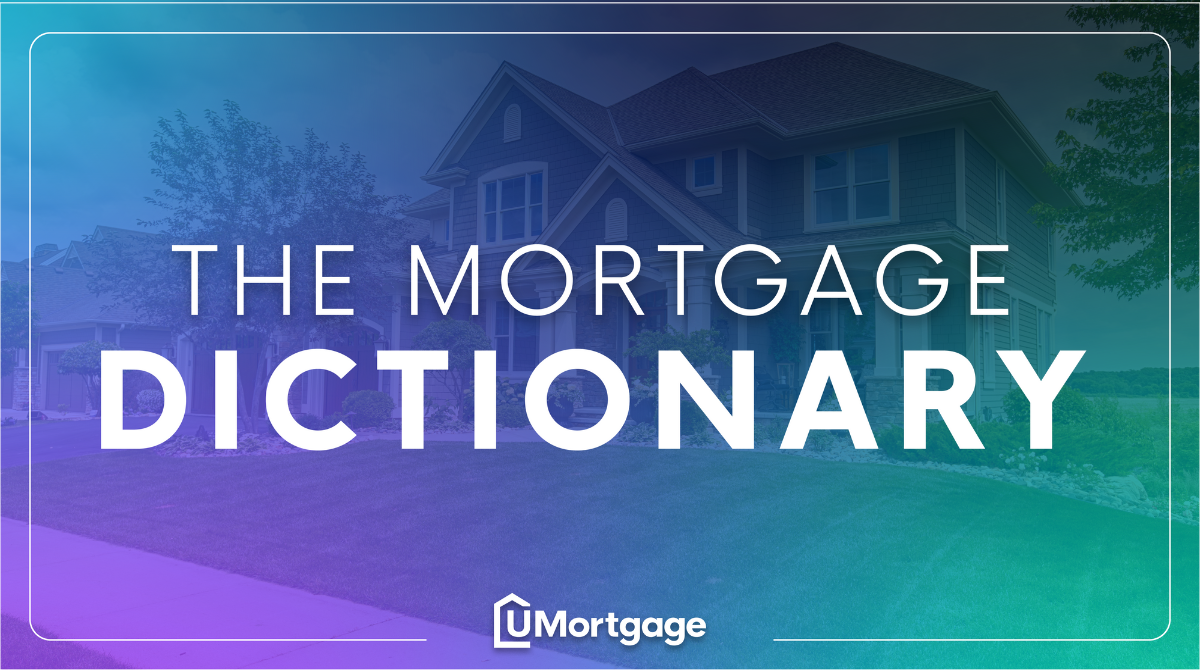Mortgage Dictionary: From A to Z
Published: December 14, 2023

Mortgage Dictionary: From A to Z
Buying a home is a huge commitment. The last thing you want during the process is to feel confused or out of the loop when you’re talking with your Realtor, Loan Originator, or any of the other key players in your homebuying journey.
Below is a glossary of some of the most common mortgage-related terms that any prospective homebuyer should know to help you become a more confident and educated borrower. If you don’t see the term you’re looking for, feel free to reach out and I’ll be more than happy to help!
30-Year Fixed Mortgage - A fixed-rate mortgage with the standard loan term of 30 years
15-Year Fixed Mortgage - A fixed-rate mortgage with half the standard 30-year loan term
3/1 ARM - An adjustable-rate mortgage that is fixed for the first three years before becoming adjustable on an annual basis.
5/1 ARM - An adjustable-rate mortgage that is fixed for the first five years before becoming adjustable on an annual basis.
Adjustable-Rate Mortgage (ARM) - A mortgage with an interest that can be changed over time depending on external factors. Most ARMS start with a period of fixed interest that lasts anywhere from 6 months to 3 years.
Amortization - A breakdown of payments showing how a loan is intended to be repaid.
Annual Percentage Rate - The rate of interest to be paid back to the mortgage lender. It can either be fixed or adjustable.
Assumption - When a person assumes responsibility for paying off a mortgage.
Appraisal - The estimation of the value of the property. Conducted by an appraiser, this process is based both on physical inspection and the sales of comparable properties in recent months.
Balloon Mortgage - A short-term mortgage that includes smaller monthly installments followed by a large lump sum payment at the loan term’s end.
Bi-Weekly Mortgage - A bi-weekly mortgage payment model that reduces interest and speeds up a payment timeline. Instead of one monthly payment or twelve payments in a calendar year, a borrower pays half of that every two weeks, adding up to thirteen total payments in a year.
Bridge Loan - A short term loan that is taken out on one property but used to purchase a different property.
Buy-Down - When you get an interest rate that is lower than the standard by paying a lender premium.
Caps - Payment caps that put limitations on own often an interest rate can be changed on an adjustable-rate mortgage (ARM).
Cash-In Refinance - A refinance in which the borrower pays additional money during the transaction that goes towards their loan and ultimately lowers their owed amount.
Cash-Out Refinance - A refinance that allows you to tap into some of the equity (your stake) in your home if you need some extra cash. You may consider a cash-out refi if you need any home renovations, pay for a large expense, or consolidate debt.
Closing - The last step in the mortgage process where documents are signed and the process is wrapped up.
Closing Costs - The costs a buyer pays during the mortgage process, including attorney fees, recording fees, and any other costs related to mortgage closing.
Construction Mortgage - A mortgage model used when a home is built rather than bought. Money is advanced directly to the builder based on the schedule of construction and is converted to a standard mortgage upon completion of the home.
Conventional Mortgage - A mortgage that is not insured or guaranteed by the federal government.
Credit History - A credit history is a record of a borrower's repayment of debts.
Credit Report - A credit report is a record of a person’s payments and loans from several sources, including banks, credit card companies, collection agencies, and the government.
Credit Score - A number assigned to an individual that indicates their capacity to repay a loan to lenders that’s based on their credit history.
Debt-to-Income Ratio – A figure that represents the difference between your monthly income and monthly debts (including a new mortgage). This figure is calculated into a percentage. The higher the percentage, the riskier the loan may be for the lender.
Down Payment - A large initial payment that a buyer puts down on their new home. Most mortgages require a down payment ranging from three percent to twenty percent of the total home value.
Equity - The difference between the amount owed on a mortgage and the current value of a home. If you owe $100,000 on your mortgage loan and your home is worth $300,000, you have $200,000 of equity in your home.
Escrow - At the closing of the mortgage, the borrowers are generally required to set aside a percentage of the yearly taxes to be held by the lender. On a monthly basis, the lender will also collect additional money to be used to pay the taxes on the home. This escrow account is maintained by the lender who is responsible for sending the tax bills on a regular basis.
Fixed-Rate Mortgage - A mortgage where the interest rate and term of a loan have been negotiated and set for the life of the loan.
Foreclosure - When a bank or lender re-possess a home or property when the borrower has not been repaying the loan.
Good Faith Estimate - An estimate of the closing costs given by the lender. While not an exact amount, it gives buyers a general idea of what to expect.
Homeowners Insurance - Property insurance for a new home. A homeowner must secure this prior to the mortgage closing date.
Loan Officer - The representative of a broker or bank who originates mortgage loans.
Loan Origination - The beginning of the loan process that is kicked off by a borrower submitting a loan application with a lender.
Loan-to-value Ratio (LTV) - A financial calculation done by dividing the amount of a mortgage by the value of the home in question.
Mortgage - A loan used to buy or refinance a home. The loan is then paid back with interest to the lender.
Mortgage Interest - The additional cost charged by a lender to a borrower throughout the repayment period of their mortgage. This is typically expressed as an annual percentage rate and can vary based on market conditions and the borrower’s financial health.
Origination Fee - A fee paid to a lender at the beginning of the mortgage process. This may include an application fee, appraisal fee, fees for all the follow-up work and other costs associated with the loan.
Par Rate - The standard interest rate determined by an underwriter.
Points - Fees paid directly to the lender at closing in exchange for a reduced interest rate. This is also called “buying down the rate,” which can lower your monthly mortgage payments.
Principal - The amount of money still owed on a mortgage. The principal amount goes down when borrowers make regular monthly or bi-weekly payments.
Private Mortgage Insurance - A type of insurance that protects lenders in case of a borrower not paying back their loan. If the borrower is paying less than 20% in a down payment, the lender will likely require them to take out PMI.
Rate and Terms Refinance - A kind of refinance that changes either the rate, term, or both rate and term of a mortgage loan. Unlike a cash-out refinance, there is no advancing of money.
Real Estate Tax Deduction - When taxes paid on personal property and real estate are deducted from federal income taxes.
Refinancing - When a person trades their old mortgage for a new one with different agreements. This can mean a lower rate, new terms, or the ability to cash out on the equity of your home.
Tax Break - A reduction in your taxes that comes from the government.
Truth in Lending - Federal mandate meant to shield consumers from potential fraud. The regulations include proper disclosure of rates, advertising guidelines, and other protections within the lending process.
Underwriter - The person who handles the insurance risk side of things for a loan process.
Interested in a mortgage loan? Get a quote today!
